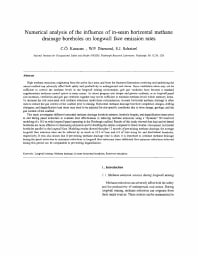Mining Publication: Numerical Analysis of the Influence of In-Seam Horizontal Methane Drainage Boreholes on Longwall Face Emission Rates
Original creation date: September 2007
Authors: C� Karacan, WP Diamond, SJ Schatzel
High methane emissions originating from the active face areas and from the fractured formations overlying and underlying the mined coalbed can adversely affect both safety and productivity in underground coal mines. Since ventilation alone may not be sufficient to control the methane levels in the longwall mining environment, gob gas ventholes have become a standard supplementary methane control option in many mines. As mines progress into deeper and gassier coalbeds, or as longwall panel size increases, ventilation and gob gas ventholes together may not be sufficient to maintain methane levels within statutory limits. To decrease the risk associated with methane emissions under these circumstances, in-seam horizontal methane drainage is often used to reduce the gas content of the coalbed prior to mining. Horizontal methane drainage borehole completion designs, drilling strategies, and degasification lead times may need to be adjusted for site-specific conditions due to mine design, geology, and the gas content of the coalbed. This study investigates different horizontal methane drainage borehole patterns, borehole lengths, and degasification times prior to and during panel extraction to evaluate their effectiveness in reducing methane emissions using a dynamic 3D reservoir modeling of a 381-m wide longwall panel operating in the Pittsburgh coalbed. Results of this study showed that dual and tri-lateral boreholes are more effective in decreasing emissions and in shielding the entries compared to fewer shorter, cross-panel, horizontal boreholes parallel to the longwall face. Modeling results showed that after 12 months of pre-mining methane drainage, the average longwall face emission rates can be reduced by as much as 10.3m3/min and 6.8 m3/min using tri- and dual-lateral boreholes, respectively. It was also shown that if pre-mining methane drainage time is short, it is important to continue methane drainage during the panel extraction to maximize reductions in longwall face emissions since additional face emission reductions achieved during this period can be comparable to pre-mining degasification.

- The Borehole Monitoring Experiment: Field Measurements of Reservoir Conditions and Responses in Longwall Panel Overburden During Active Mining
- A CART Technique to Adjust Production from Longwall Coal Operations under Ventilation Constraints
- Comparisons Between Cross-Measure Boreholes and Surface Gob Holes
- Degasification System Selection for U.S. Longwall Mines Using an Expert Classification System
- Effect of a Surface Borehole on Longwall Gob Degasification (Pocahontas No. 3 Coalbed)
- Longwall Gob Degasification With Surface Ventilation Boreholes Above the Lower Kittanning Coalbed
- Methane Control on Longwalls with Cross-Measure Boreholes (Lower Kittanning Coalbed)
- Modeling and Prediction of Ventilation Methane Emissions of U.S. Longwall Mines Using Supervised Artificial Neural Networks
- Reservoir Engineering Considerations for Coal Seam Degasification and Methane Control in Underground Mines
- Technology News 465 - Method for Predicting Methane Emissions on Extended Longwall Faces